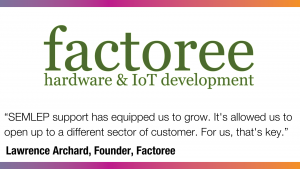
Factoree is a Milton Keynes-based tech consultancy. Their talented cross-disciplinary team develops engineering solutions that enable businesses to participate in the Internet of Things (IoT) or connected product spaces. The IoT describes an interconnected network of physical objects that use technology to connect with and exchange information with other devices and systems – the IoT includes smart thermostats, fitness trackers, medical sensors, and many more ‘smart’ devices. From electronic engineering to firmware development and mechanical and industrial design, Factoree supports startups, SMEs, and global organisations as they create physical solutions that make virtually connected products and services possible.
What challenge did Factoree face?
Factoree founder Lawrence Archard explains that the consultancy has historically had a long sales funnel – around 18 months to two years. Sales leads were often generated through networking, so during the pandemic when in-person meetups ground to a halt, it was difficult to nurture potential customers. This meant, as the world began to open up, Factoree saw a reduction in projects – those historic sales leads were simply not there to fill up their calendar.
Lawrence also recognised that the business was working in an unstructured way, adapting processes to meet the needs of whichever client they were dealing with at the time. This offered great flexibility, but also made it challenging to effectively monitor and manage multiple projects. He identified an opportunity to transform their working systems and become more efficient.
How did SEMLEP provide support?
Lawrence was aware of local enterprise partnerships (LEPs) around the country – often providing tech mentoring support himself through their schemes. However, he initially connected with SEMLEP through Steve Hayward at Digital Future First who made him aware of the SEMSUP grant and provided support through the application process alongside Adam Lawton from the University of Northampton. He successfully applied for SEMLEP funding to take part in a course at the Cranfield School of Management.
The course at Cranfield helped Lawrence to carry out a detailed self-evaluation of Factoree and he then worked with SEMLEP business advisor Kelly Bowman to identify opportunities to make positive changes as well as other services and grants that could help the organisation to meet its business goals. Key areas of focus for Factoree were business growth, increasing the number of projects the team could juggle at any one time, and targeting faster-converting clients. Lawrence explains:
“During the pandemic, we weren’t too badly affected, because we were working on projects that had begun two, three years ago, or the relationships had begun two or three years ago. With there being no in-person networking, for the last couple of years, we saw a completely empty pipeline from the start of this year. We knew we had to be looking at a different type of client, who would convert much quicker.”
Factoree received a £3000 matched-funding grant to develop a specialist ‘dashboard’ website with the support of MCQN.com, demonstrating the use of live sensor data. A further £3000 Recovery and Resilience Grant was used to instruct John Guinn – freelance journalist and copywriter – to create several case studies and to engage a business systems consultant – Vicky McKenna – to evaluate operational processes. This process helped Lawrence to identify a need for admin support and, potentially, an operations manager to support the smooth running of the business.
Lawrence says that working with business advisor Kelly was “great”, adding that her ability to get to the heart of the challenges Factoree faced was impressive:
“I’ve had various bits of business advisor type support. It sometimes takes a long, long time for the other person to pick up what the problems are. And even longer for me to realise those things … Whereas Kelly pretty much picked it up in the first 20 minutes! She got to the crux of it straight away.”
Factoree is already putting the key changes they identified as a result of SEMLEP support into practice, and the results have been very positive. Lawrence believes that the most important part of the SEMLEP experience was the push it gave him to take meaningful action:
“It was impetus. They were all things that I – deep down – probably knew needed to be done. But the problem is when you’ve got client work, unless you’ve got someone saying, ‘this needs to be done’ those things normally slip aside in favour of the client who’s shouting loudest.”